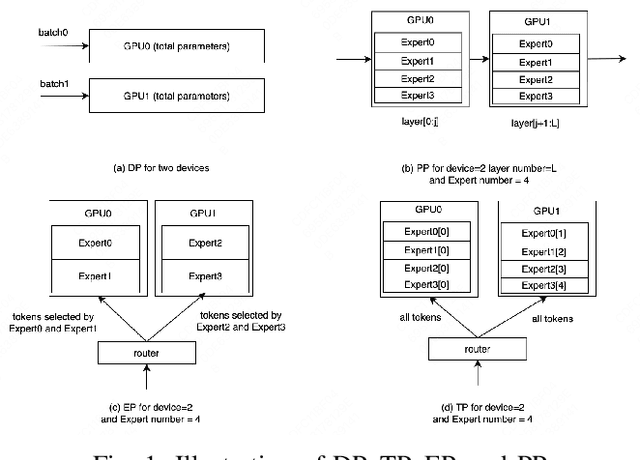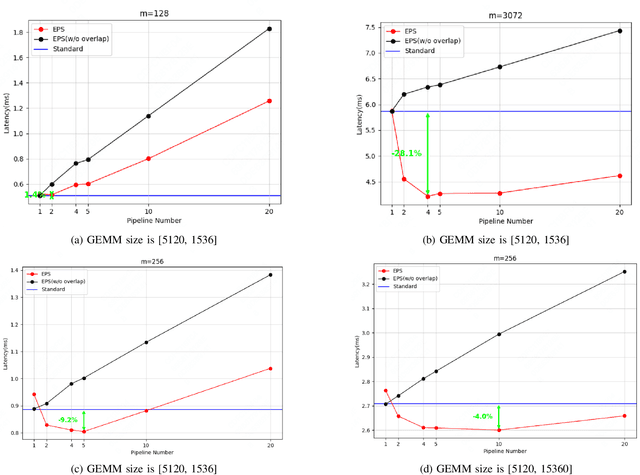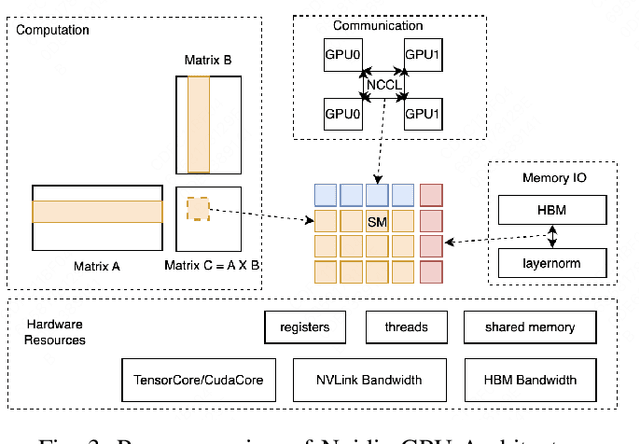Yulei Qian
EPS-MoE: Expert Pipeline Scheduler for Cost-Efficient MoE Inference
Oct 16, 2024



Abstract:Large Language Model (LLM) has revolutionized the field of artificial intelligence, with their capabilities expanding rapidly due to advances in deep learning and increased computational resources. The mixture-of-experts (MoE) model has emerged as a prominent architecture in the field of LLM, better balancing the model performance and computational efficiency. MoE architecture allows for effective scaling and efficient parallel processing, but the GEMM (General Matrix Multiply) of MoE and the large parameters introduce challenges in terms of computation efficiency and communication overhead, which becomes the throughput bottleneck during inference. Applying a single parallelism strategy like EP, DP, PP, etc. to MoE architecture usually achieves sub-optimal inference throughput, the straightforward combinations of existing different parallelisms on MoE can not obtain optimal inference throughput yet. This paper introduces EPS-MoE, a novel expert pipeline scheduler for MoE that goes beyond the existing inference parallelism schemes. Our approach focuses on optimizing the computation of MoE FFN (FeedForward Network) modules by dynamically selecting the best kernel implementation of GroupGemm and DenseGemm for different loads and adaptively overlapping these computations with \textit{all2all} communication, leading to a substantial increase in throughput. Our experimental results demonstrate an average 21% improvement in prefill throughput over existing parallel inference methods. Specifically, we validated our method on DeepSeekV2, a highly optimized model claimed to achieve a prefill throughput of 100K tokens per second. By applying EPS-MoE, we further accelerated it to at least 120K tokens per second.
Pick of the Bunch: Detecting Infrared Small Targets Beyond Hit-Miss Trade-Offs via Selective Rank-Aware Attention
Aug 07, 2024Abstract:Infrared small target detection faces the inherent challenge of precisely localizing dim targets amidst complex background clutter. Traditional approaches struggle to balance detection precision and false alarm rates. To break this dilemma, we propose SeRankDet, a deep network that achieves high accuracy beyond the conventional hit-miss trade-off, by following the ``Pick of the Bunch'' principle. At its core lies our Selective Rank-Aware Attention (SeRank) module, employing a non-linear Top-K selection process that preserves the most salient responses, preventing target signal dilution while maintaining constant complexity. Furthermore, we replace the static concatenation typical in U-Net structures with our Large Selective Feature Fusion (LSFF) module, a dynamic fusion strategy that empowers SeRankDet with adaptive feature integration, enhancing its ability to discriminate true targets from false alarms. The network's discernment is further refined by our Dilated Difference Convolution (DDC) module, which merges differential convolution aimed at amplifying subtle target characteristics with dilated convolution to expand the receptive field, thereby substantially improving target-background separation. Despite its lightweight architecture, the proposed SeRankDet sets new benchmarks in state-of-the-art performance across multiple public datasets. The code is available at https://github.com/GrokCV/SeRankDet.
Sparse Prior Is Not All You Need: When Differential Directionality Meets Saliency Coherence for Infrared Small Target Detection
Jul 22, 2024Abstract:Infrared small target detection is crucial for the efficacy of infrared search and tracking systems. Current tensor decomposition methods emphasize representing small targets with sparsity but struggle to separate targets from complex backgrounds due to insufficient use of intrinsic directional information and reduced target visibility during decomposition. To address these challenges, this study introduces a Sparse Differential Directionality prior (SDD) framework. SDD leverages the distinct directional characteristics of targets to differentiate them from the background, applying mixed sparse constraints on the differential directional images and continuity difference matrix of the temporal component, both derived from Tucker decomposition. We further enhance target detectability with a saliency coherence strategy that intensifies target contrast against the background during hierarchical decomposition. A Proximal Alternating Minimization-based (PAM) algorithm efficiently solves our proposed model. Experimental results on several real-world datasets validate our method's effectiveness, outperforming ten state-of-the-art methods in target detection and clutter suppression. Our code is available at https://github.com/GrokCV/SDD.
One-Stage Cascade Refinement Networks for Infrared Small Target Detection
Dec 31, 2022



Abstract:Single-frame InfraRed Small Target (SIRST) detection has been a challenging task due to a lack of inherent characteristics, imprecise bounding box regression, a scarcity of real-world datasets, and sensitive localization evaluation. In this paper, we propose a comprehensive solution to these challenges. First, we find that the existing anchor-free label assignment method is prone to mislabeling small targets as background, leading to their omission by detectors. To overcome this issue, we propose an all-scale pseudo-box-based label assignment scheme that relaxes the constraints on scale and decouples the spatial assignment from the size of the ground-truth target. Second, motivated by the structured prior of feature pyramids, we introduce the one-stage cascade refinement network (OSCAR), which uses the high-level head as soft proposals for the low-level refinement head. This allows OSCAR to process the same target in a cascade coarse-to-fine manner. Finally, we present a new research benchmark for infrared small target detection, consisting of the SIRST-V2 dataset of real-world, high-resolution single-frame targets, the normalized contrast evaluation metric, and the DeepInfrared toolkit for detection. We conduct extensive ablation studies to evaluate the components of OSCAR and compare its performance to state-of-the-art model-driven and data-driven methods on the SIRST-V2 benchmark. Our results demonstrate that a top-down cascade refinement framework can improve the accuracy of infrared small target detection without sacrificing efficiency. The DeepInfrared toolkit, dataset, and trained models are available at https://github.com/YimianDai/open-deepinfrared to advance further research in this field.
Distributed Hierarchical GPU Parameter Server for Massive Scale Deep Learning Ads Systems
Mar 12, 2020



Abstract:Neural networks of ads systems usually take input from multiple resources, e.g., query-ad relevance, ad features and user portraits. These inputs are encoded into one-hot or multi-hot binary features, with typically only a tiny fraction of nonzero feature values per example. Deep learning models in online advertising industries can have terabyte-scale parameters that do not fit in the GPU memory nor the CPU main memory on a computing node. For example, a sponsored online advertising system can contain more than $10^{11}$ sparse features, making the neural network a massive model with around 10 TB parameters. In this paper, we introduce a distributed GPU hierarchical parameter server for massive scale deep learning ads systems. We propose a hierarchical workflow that utilizes GPU High-Bandwidth Memory, CPU main memory and SSD as 3-layer hierarchical storage. All the neural network training computations are contained in GPUs. Extensive experiments on real-world data confirm the effectiveness and the scalability of the proposed system. A 4-node hierarchical GPU parameter server can train a model more than 2X faster than a 150-node in-memory distributed parameter server in an MPI cluster. In addition, the price-performance ratio of our proposed system is 4-9 times better than an MPI-cluster solution.
 Add to Chrome
Add to Chrome Add to Firefox
Add to Firefox Add to Edge
Add to Edge